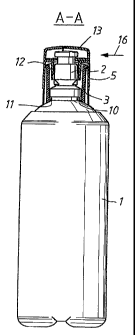Some of the information on this Web page has been provided by external sources. The Government of Canada is not responsible for the accuracy, reliability or currency of the information supplied by external sources. Users wishing to rely upon this information should consult directly with the source of the information. Content provided by external sources is not subject to official languages, privacy and accessibility requirements.
Any discrepancies in the text and image of the Claims and Abstract are due to differing posting times. Text of the Claims and Abstract are posted:
| (12) Patent: | (11) CA 2417447 |
|---|---|
| (54) English Title: | AN EASILY CARRIED EYE RINSING DEVICE |
| (54) French Title: | DISPOSITIF DE RINCAGE DES YEUX FACILE A PORTER |
| Status: | Deemed expired |
| (51) International Patent Classification (IPC): |
|
|---|---|
| (72) Inventors : |
|
| (73) Owners : |
|
| (71) Applicants : |
|
| (74) Agent: | SMART & BIGGAR IP AGENCY CO. |
| (74) Associate agent: | |
| (45) Issued: | 2008-01-08 |
| (86) PCT Filing Date: | 2001-10-16 |
| (87) Open to Public Inspection: | 2002-04-25 |
| Examination requested: | 2004-01-27 |
| Availability of licence: | N/A |
| (25) Language of filing: | English |
| Patent Cooperation Treaty (PCT): | Yes |
|---|---|
| (86) PCT Filing Number: | PCT/SE2001/002248 |
| (87) International Publication Number: | WO2002/032371 |
| (85) National Entry: | 2003-01-24 |
| (30) Application Priority Data: | ||||||
|---|---|---|---|---|---|---|
|
An easily carried eye rinsing device in the form of a flask (1) containing an
eye rinsing liquid, wherein the flask is sealed by a closure element (2) which
projects up from the future opening of the flask and is provided with an eye
cup (3). The invention is characterised in that the eye cup (3) surrounds the
closure element (2); in that a sleeve (5) surrounds the eye cup; and in that
the sleeve (5) is non-rotatably affixed in the closure element (2).
Cette invention se rapporte à un dispositif de rinçage des yeux facile à porter, se présentant sous la forme d'un flacon (1) et contenant un liquide de rinçage des yeux. Le flacon est fermé hermétiquement par un élément de fermeture (2) qui est saillant depuis l'ouverture du flacon et qui est pourvu d'un oeilleton (3). Cette invention se caractérise en ce que l'oeilleton (3) entoure l'élément de fermeture (2); un manchon (5) entoure l'oeilleton; et le manchon (5) est fixé non rotatif dans l'élément de fermeture (2).
Note: Claims are shown in the official language in which they were submitted.
Note: Descriptions are shown in the official language in which they were submitted.

For a clearer understanding of the status of the application/patent presented on this page, the site Disclaimer , as well as the definitions for Patent , Administrative Status , Maintenance Fee and Payment History should be consulted.
| Title | Date |
|---|---|
| Forecasted Issue Date | 2008-01-08 |
| (86) PCT Filing Date | 2001-10-16 |
| (87) PCT Publication Date | 2002-04-25 |
| (85) National Entry | 2003-01-24 |
| Examination Requested | 2004-01-27 |
| (45) Issued | 2008-01-08 |
| Deemed Expired | 2020-10-16 |
There is no abandonment history.
| Fee Type | Anniversary Year | Due Date | Amount Paid | Paid Date |
|---|---|---|---|---|
| Application Fee | $300.00 | 2003-01-24 | ||
| Registration of a document - section 124 | $100.00 | 2003-02-27 | ||
| Maintenance Fee - Application - New Act | 2 | 2003-10-16 | $100.00 | 2003-09-24 |
| Request for Examination | $800.00 | 2004-01-27 | ||
| Maintenance Fee - Application - New Act | 3 | 2004-10-18 | $100.00 | 2004-09-20 |
| Maintenance Fee - Application - New Act | 4 | 2005-10-17 | $100.00 | 2005-09-27 |
| Maintenance Fee - Application - New Act | 5 | 2006-10-16 | $200.00 | 2006-09-26 |
| Final Fee | $300.00 | 2007-09-28 | ||
| Maintenance Fee - Application - New Act | 6 | 2007-10-16 | $200.00 | 2007-10-04 |
| Maintenance Fee - Patent - New Act | 7 | 2008-10-16 | $200.00 | 2008-10-03 |
| Maintenance Fee - Patent - New Act | 8 | 2009-10-16 | $200.00 | 2009-09-24 |
| Maintenance Fee - Patent - New Act | 9 | 2010-10-18 | $200.00 | 2010-09-17 |
| Maintenance Fee - Patent - New Act | 10 | 2011-10-17 | $250.00 | 2011-09-28 |
| Maintenance Fee - Patent - New Act | 11 | 2012-10-16 | $250.00 | 2012-10-10 |
| Maintenance Fee - Patent - New Act | 12 | 2013-10-16 | $250.00 | 2013-10-08 |
| Maintenance Fee - Patent - New Act | 13 | 2014-10-16 | $250.00 | 2014-10-14 |
| Maintenance Fee - Patent - New Act | 14 | 2015-10-16 | $250.00 | 2015-09-24 |
| Maintenance Fee - Patent - New Act | 15 | 2016-10-17 | $450.00 | 2016-09-27 |
| Maintenance Fee - Patent - New Act | 16 | 2017-10-16 | $450.00 | 2017-10-10 |
| Maintenance Fee - Patent - New Act | 17 | 2018-10-16 | $450.00 | 2018-10-09 |
Note: Records showing the ownership history in alphabetical order.
| Current Owners on Record |
|---|
| CEDERROTH INTERNATIONAL AB |
| Past Owners on Record |
|---|
| AHLSTROM, TOM |
| EHRICH, HANS |
| RATJEN, JOCHEN |